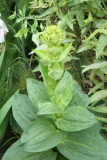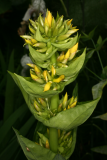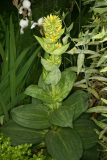Additional notes (click to expand)
Commemorative
This popular genus of garden plants is named after Gentius, King of Illyria (the western Balkan Peninsula) in 181–168 BC. Gentius had a powerful navy of 270 warships (lembi) and like most kings of this era he fought constant wars, fi ghting with the Romans against Macedonia, and then changing sides only to be defeated and brought captive to Rome in 168 BC. The species name of G. asclepiadea refers to Asclepius, the Greek god of medicine (qv Asclepias tuberosa, p26). Gentius ‘discovered’ the medicinal value of the root of Gentiana lutea according to Dioscorides, who recommends it for animal bites, sprains, healing wounds and (as a pessary) as an abortifacient.
Oakeley, Dr. Henry. (2012). Doctors in the Medicinal Garden. Plants named after physicians. Royal College of Physicians.
link
Medicinal
Traditional Herbal Medicine Registration (THMR).
Gentius ‘discovered’ the medicinal value of the root of Gentiana lutea according to Dioscorides, who recommends it for animal bites, sprains, healing wounds and (as a pessary) as an abortifacient. Later authors note its bitter taste, and quote Galen as thus indicating its use as a purgative.
Oakeley, Dr. Henry. (2012). Doctors in the Medicinal Garden. Plants named after physicians. Royal College of Physicians.
link
Culpeper: "... some call it Felwort or Baldmoney. It is ... a notable counterpoison, it opens obstructions, helps the bitings of venomous beasts, and mad dogs, helps digestion, and cleanseth the body of raw humours; our chyrugians [surgeons] use the root in the form of a tent to open the sore, they are also very profitable for ruptures [hernias] or such as are burnt.”
Culpeper, Nicholas. (1650). A Physical Directory . London, Peter Cole. p.8
Medicinal uses
Uses supported by clinical data
None. For the results of three uncontrolled human studies, see Clinical
pharmacology (20–22). Although the fi ndings suggest that Radix Gentianae
Luteae may be of benefi t for the treatment of dyspepsia, data from
controlled clinical trials are currently lacking.
Uses described in pharmacopoeias and well established documents
Treatment of digestive complaints, such as loss of appetite, feeling of distension
and fl atulence (23). As an appetite stimulant during convalescence (24).
Uses described in traditional medicine
As a carminative, depurative, emmenagogue, febrifuge, tranquillizer and
tonic, and to facilitate labour (8, 10). Treatment of diabetes and dysmenorrhoea
(10).
Contraindications
Owing to potential mutagenic activity (36–38), and its traditional use as
an emmenagogue (10), Radix Gentianae Luteae should not be administered
during pregnancy or nursing, or to small children. Radix Gentianae
Luteae is contraindicated in gastric or duodenal ulcer, high blood pressure
(11) and hyperacidity (7, 24).
WHO Monographs on Selected Medicinal Plants. Volume 3. 2007. WHO, Geneva
Nomenclature
Named after Gentius, King of Illyria (the western Balkan Peninsula) in 181–168 BC. Gentius had a powerful navy of 270 warships (lembi) and like most kings of this era he fought constant wars, fighting with the Romans against Macedonia, and then changing sides only to be defeated and brought captive to Rome in 168 BC.
Oakeley, Dr. Henry. (2012). Doctors in the Medicinal Garden. Plants named after physicians. Royal College of Physicians.
link
Felwort, Baldmoney. Gentiana from King Gentius.
Culpeper, Nicholas. (1650). A Physical Directory . London, Peter Cole. p.8
Other use
The root is still used as the bittering agent in Angostura bitters, the basis for a ‘Pink Gin’, and in herbal medicine for everything from malaria to snakebite. It is not the source of Gentian violet, a blue-purple dye, which is derived from coal tar.
Oakeley, Dr. Henry. (2012). Doctors in the Medicinal Garden. Plants named after physicians. Royal College of Physicians.
link
Food additive.
Germplasm Resources Information Network (GRIN) at www.ars-grin.gov/cgi-bin/npgs/html/tax_search.pl
Toxicity
Poisoning by using the roots of the very similar looking plants of Veratrum species for making alcoholic beverages has caused fatal and non-fatal poisoning.
https://www.sciencedirect.com/topics/pharmacology-toxicology-and-pharmaceutical-science/gentiana-lutea accessed 18 Feb 2019
Podcast
Gentiana lutea L.
Family: GENTIANACEAEGenus: Gentiana
Species: lutea L.
Common names: Great Yellow Gentian
Pharmacopoeia Londinensis name: Gentiana
Distribution summary: European mountains
Habit: Perennial
Hardiness: H5 - Hardy; cold winter
Garden status: Not currently grown
Reason for growing: Commemorative, medicinal, other use, traditional herbal registration




